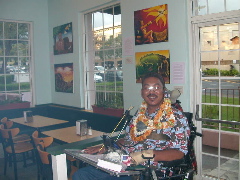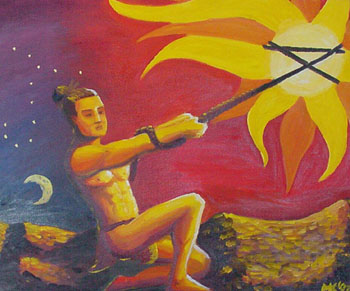Success Stories: Persons with Disabilities
Matthew Kaopio (2004, reprinted from Hawaiian Consortium for the Arts)
“Outsider” artist emerges as native Hawaiian arts and business leader by Susan Killeen

Matthew Kaopio is running late for his appointment with me at Volcano Joe’s Coffee House. I can see him zipping across the intersection on University Avenue from my table at the window. His motorized wheelchair handles the bumps pretty well as he sails across street in my direction.
“Sorry,” he apologizes. “My meeting on campus ran late.” The Kamehameha Schools graduate is the one of the founding Hawaii artists in a newly emerging professional business initiative for native Hawaiian artists and others with disabilities. Currently a UH-Manoa graduate student, Matthew has interests in screenwriting and storytelling, which complement his passion for the visual arts.
I move a few chairs and make space for his wheelchair at the table, and we each order a latte and a mango bar.
Matthew’s eyes sparkle as he speaks. He is an engaging presence and has a disarming manner. He’s brought along the mock-up of his upcoming book, “Hawaiian Family Legends,” a combination of his oil paintings of Hawaiian mythological themes and accompanying text. It is being published locally by Bennett Hymer, Mutual Publishing.

I’m struck by the expressions on his figures and suddenly remember that he’s painted these with his mouth.
“I’ve liked art ever since I can remember,” he says. “When I was a kid, I’d draw on the blank pages of my children’s books, thinking that the publisher left them blank for that purpose, so that I could draw my own story.” Since he no longer dances hula, an art form he was quite good at before his accidents, Matthew is an accomplished chanter, which he says is a form of oral poetry.
“Chanting and poetry are ways of harnessing the spiritual and magical power of the spoken word.”
Matthew’s story is an impressive one. He grew up on Kauai, surfing, biking, paddling, hiking the Napali Coast, and gathering flowers and maile leaves for his aunties who made haku lei.
In 1994, at age 22 the dove into the waters of Slippery Slide and sustained a spinal injury that paralyzed him from below the shoulders down. For two dark years he stayed at home and didn’t do much of anything until someone suggested a painting class at Louise V Creative Arts Program at the Rehab Hospital of the Pacific. Matthew has transitions with other artist to create an artist studio at the Lyon Arboretum with VSA arts of Hawaii-Pacific and the University of Hawaii College of Education, Center on Disability Studies.
“It really kicked my butt,” he says, remembering the challenge of those first few months. “We had to do a self-portrait, so it forced me to look at myself in the chair and see me.” Painting also became a way to channel some of his anger and frustration early on. “At first I was pretty impatient. Before my accident I could whip out a couple of portraits a day. Now I may work on a piece for weeks, even months.”
As I turn the pages of his book, I can see his commitment to himself and his own re-emergence. The other painters in the program were his mentors, he tells me. “The painting showed me what I was capable of and I enrolled in school. I really pushed myself and took four classes that first semester. The professors encouraged me to test my limits.” And he did. Matthew will receive his Masters Degree this year in Pacific Island Studies.
I offer him a sip of his latte and a forkful of the mango bar. “The concept is a large part of the art for me. Hawaiian stories have hidden meaning and ambiguities you can play with. Mythologies have always interested me—not only Native Hawaiian—but Chinese, Native American, and Greek as well.”
“What I’ve done here is to marry this new art form with the Hawaiian culture,” he says, referring to his book. “Hawaiians didn’t paint, but it’s an art form well-suited to my disability.”
Susan Miller, co-director of VSA arts of Hawaii-Pacific says, “Matthew is not only an established artist, but one of the emerging leaders in the Artists with Disabilities movement. We’re thrilled to be mentoring him and seeing him develop professionally. He is intelligent, funny and extremely self-determined.”
Matthew starts his day at about 6:30 a.m. in order to be on-campus by 10:00 a.m.
“There are about four hours of preparation for the day—showering and handling my basic necessities,” he tells me. His day might include several Hawaiian language classes and Hawaiian theatre, a trip to the library and a few meetings, and then catching the Handy Van home at 5 or 6 p.m. Two hours, one way from Ewa Gentry to UH-Manoa campus.
“When I comment on his full schedule,” he says, “The worst disability is a bad attitude.” Matthew would like to demystify the issue of a disability.
“People don’t really know how to approach someone in a wheelchair. I’d like to help the public change that ‘them and us’ viewpoint. People with disabilities have the capacity to be very resilient, because they have to find creative ways to resolve issues. If I need a book off the shelf in the library, I have to figure out how to get it.”
(At the time of this writing) Matthew is preparing to attend a conference of the Mouth and Foot Painters Association of America in Atlanta on April 28. This will be his first trip to the mainland. His brother, and primary caregiver, K. Kekai Kaopio will join him on the journey. “There are a lot of unknowns about the logistics of just getting there: the flight, the hotel and accessibility in general,” he says, “but we’ll do it.”
The conference promises workshops, exhibits and classes to instruct artists in their craft. “I'm really looking forward to the fellowship, he says, noting that people will travel from across the United States and Canada to attend. Then he smiles. “It's also the same day as my birthday.” He’ll be 31. He’s obviously enjoying the serendipity of the two events. “I've certainly come a long way,” he says.
“The painting was really a gift.” We’re leaving the coffee shop as the Handi Van approaches. I find myself thinking: you are the gift, Matthew. Happy Birthday.

